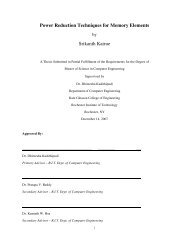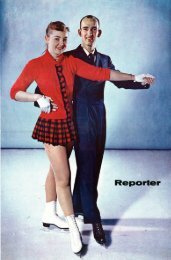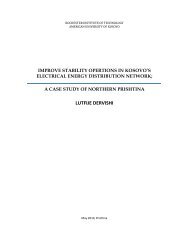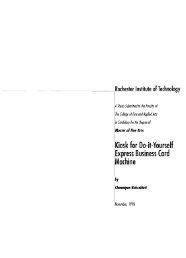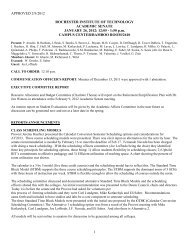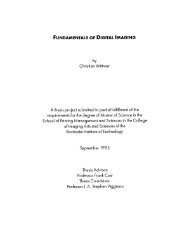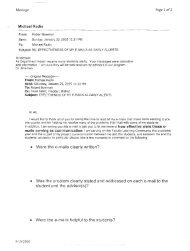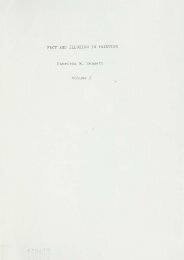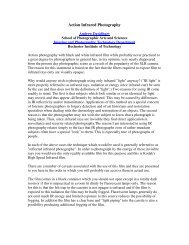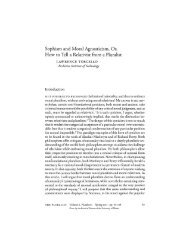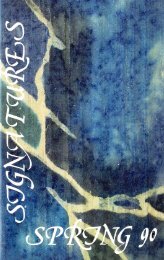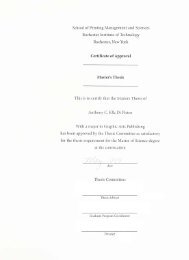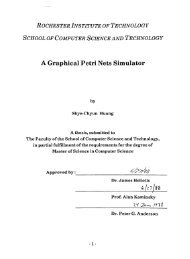Self-Portrait as the Allegory of Painting (La Pittura) Maureen Lester ...
Self-Portrait as the Allegory of Painting (La Pittura) Maureen Lester ...
Self-Portrait as the Allegory of Painting (La Pittura) Maureen Lester ...
You also want an ePaper? Increase the reach of your titles
YUMPU automatically turns print PDFs into web optimized ePapers that Google loves.
portrait <strong>of</strong> 1650, in which he reversed Cerrini's arrangement, placing himself <strong>as</strong> <strong>the</strong> living<br />
character painting an image <strong>of</strong> <strong>Pittura</strong> (106). Yet even in <strong>the</strong>se, <strong>the</strong> artist is separate from <strong>the</strong> art<br />
he creates. Fur<strong>the</strong>rmore, <strong>the</strong>se means <strong>of</strong> combining <strong>the</strong> two <strong>the</strong>mes were <strong>of</strong>ten elaborate and<br />
complicated, at odds with <strong>the</strong> public's desire for abstract ide<strong>as</strong> to be rendered in clear, simple,<br />
cohesive images (106).<br />
In contr<strong>as</strong>t to previous attempts to link <strong>the</strong> allegorical with portraiture, if it is an actual<br />
self-portrait, Ariemisia's piece is radically simplified (Garrard 106). The composition takes<br />
many <strong>of</strong> its details directly from Cesare Ripa's Iconologia (Christiansen and Mann 417).<br />
Iconologia w<strong>as</strong> originally published in 1593, and provided an index <strong>of</strong> allegorical figures,<br />
gestures and attributes to be used by painters (Pingel, par. 4). In fact, Ripa's description <strong>of</strong><br />
"<strong>Painting</strong>," though not exactly a description <strong>of</strong> <strong>the</strong> painting, sounds very similar to <strong>the</strong><br />
Artemisia's piece:<br />
A beautiful woman, with full black hair, disheveled, and twisted in various ways, with<br />
arched eyebrows that show imaginative thought, <strong>the</strong> mouth covered with a cloth tied<br />
behind her ears, with a chain <strong>of</strong> gold at her throat from which hangs a m<strong>as</strong>k, and h<strong>as</strong><br />
written in front "imitation." She holds in her hand a brush, and in <strong>the</strong> o<strong>the</strong>r <strong>the</strong> palette,<br />
with clo<strong>the</strong>s <strong>of</strong> evanescently covered drapery... (Christiansen and Mann 417-18).<br />
<strong>La</strong> <strong>Pittura</strong>, does indeed feature a young woman with dark hair in a ra<strong>the</strong>r unkempt state, with a<br />
chain featuring a m<strong>as</strong>k pendant (67). Brush in hand, <strong>the</strong> figure reaches forward <strong>as</strong> if to apply to<br />
first strokes to a blank canv<strong>as</strong>, with one hand, while her o<strong>the</strong>r holds a palette (67). The painting<br />
is signed "A.G.F." with <strong>the</strong> "F" most likely referring to a variation <strong>of</strong> <strong>the</strong> <strong>La</strong>tin verb fecere,<br />
meaning "to make (Christiansen and Mann 418).<br />
371



